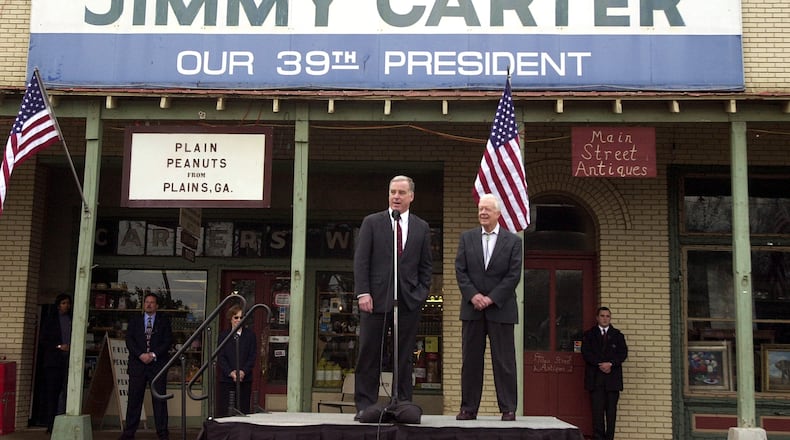For anyone looking for a sign from above, this one was awfully hard to miss.
For much of Wednesday morning, fog and even some intermittent drizzle had shrouded the field of solar panels recently constructed on a piece of farmland owned here by Jimmy Carter. Then, just as he and his wife, Rosalynn, cut the ceremonial ribbon on a project that will bring renewable energy to much of their beloved hometown, the sun burst out overhead, as if to underscore the significance of this long-in-the-making moment.
"This site will be as symbolically important as the 32 panels we put on the White House," Carter had earlier told a crowd of about 100 people — and one persistently crowing rooster nearby. "People can come here and see what can be done."
The 45-minute ceremony officially marked the completion of an ambitious project by Atlanta-based SolAmerica Energy to construct solar panels on a 10-acre site leased from Carter. It also brought full circle a personal commitment to renewable energy on Carter’s part that first burst into view in 1979 when he had solar panels installed on the White House roof.
Now, some 37 years after voters turned him out of that temporary home in Washington D.C. — and his successor, Ronald Reagan, dismantled his ahead-of-its-time roof project — the field of 3,852 panels that rotate with the path of the sun lies about half a mile from the modest ranch house where he and Rosalynn have lived since 1961.
“I won’t use the word ‘vindicated,’” Carter said with a chuckle Wednesday in response to a question about how “hot” solar power and other forms of renewable energy have become now. “But I feel pleased … that’s a more political word to use!”
The project will provide over 50 percent of the power needs of Plains, a snug Sumter County town of 683 people located approximately ten minutes from Americus. With three Jimmy Carter National Historic Site locations operated by the National Park Service and a block-and-a-half long business district that primarily caters to tourists, the increased reliance on renewable energy will be economically beneficial to Plains and to its approximately 215 homes, SolAmerica executive vice president George Mori told the crowd.
>> Got a question about the news? See our explainers here
"In the first year … there'll be enough solar power to power 200 homes," Mori said. "That's really remarkable."
But that’s not the only reason he and his colleagues were so geeked to be working with Carter, Mori admitted in an interview.
“In our industry, he’s somewhat of a hero for his vision around renewable energy and the growing need for it for energy independence and also for environmental reasons,” Mori said of Carter, who also created the U.S. Department of Energy during his term as president. During their first meeting about the project, Carter discussed the long-ago installation and subsequent removal of those 32 panels. Said Mori: “That is somewhat legendary in our industry.”
But making a town go solar isn’t as easy as flipping a switch. Mori first approached a friend several years ago about the possibility of working with the ex-president. He was “thrilled” when that friend, former Georgia state senator and Democratic gubernatorial candidate Jason Carter, reported back that his famous grandfather was interested in the idea.
“It was an easy sell, as you can probably imagine, to call the person I call Paw Paw and say, ‘Hey, how much would you like to put a solar installation on your farm?’” a grinning Jason Carter told the crowd on Wednesday. “And he said, ‘How big? When can we do it?!’”
Carter is famously hands-on. And apparently, a solar farm located practically in his own backyard is no exception. During construction, “I think he visited it every day he was in Plains,” said Mori, recalling one day when Carter studied the plans laid out in the back of a pickup truck and asked a series of “very smart questions.”
And now?
“We just turn the corner, and we can see it,” Carter said with a smile Wednesday. “Every time Rosalynn and I walk down the street, we look over to see that (the solar panels) are tracking well.”
About the Author
The Latest
Featured

